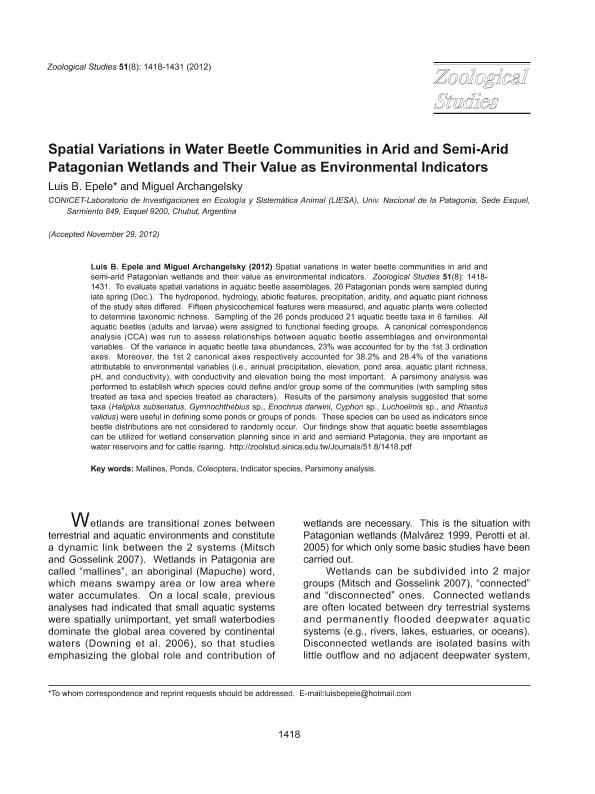Mostrar el registro sencillo del ítem
dc.contributor.author
Epele, Luis Beltran

dc.contributor.author
Archangelsky, Miguel

dc.date.available
2023-06-05T15:37:08Z
dc.date.issued
2012-12
dc.identifier.citation
Epele, Luis Beltran; Archangelsky, Miguel; Spatial variation of water beetle communities in arid and semi-arid Patagonian wetlands and their value as environmental indicators; Academia Sinica; Zoological Studies; 51; 8; 12-2012; 1418-1431
dc.identifier.issn
1021-5506
dc.identifier.uri
http://hdl.handle.net/11336/199563
dc.description.abstract
To evaluate the spatial variation of aquatic beetle assemblages, 26 Patagonian ponds were sampled during late spring (December). Study sites differed in hydroperiod, hydrology, abiotic features, precipitation, aridity and aquatic plant richness. 15 physico-chemical features were measured and aquatic plants were collected to determine taxonomic richness. The sampling of the 26 ponds produced 21 aquatic beetle taxa distributed in six families. All aquatic beetles (adults and larvae) were assigned to functional feeding groups. A canonical correspondence analysis (CCA) was run to assess relationships between aquatic beetle assemblages and environmental variables. 23% of the variance in aquatic beetle taxa abundance was accounted for by the first three ordination axes. Moreover, the first two canonical axes accounted for 38.2% and 28.4% of the variation attributable to the environmental variables (annual precipitation, altitude, pond area, aquatic plant richness, pH and conductivity), being conductivity and altitude the most important. A parsimony analysis was performed in order to establish which species could define and/or group some of the communities (sampling sites were treated as taxa and species were treated as characters). The results of the parsimony analysis suggest that some taxa (Haliplus subseriatus, Gymnochthebius sp., Enochrus darwini, Cyphon sp., Luchoelmis sp. and Rhantus validus) are useful to define some ponds or groups of ponds. These species could be used as indicators since beetle distributions are not to be considered random. Our findings point out that aquatic beetle assemblages could be utilised for wetlands conservation planning since in arid and semiarid Patagonia they are important as water reservoirs and also for cattle rearing.
dc.format
application/pdf
dc.language.iso
eng
dc.publisher
Academia Sinica

dc.rights
info:eu-repo/semantics/openAccess
dc.rights.uri
https://creativecommons.org/licenses/by-nc-sa/2.5/ar/
dc.subject
MALLINES
dc.subject
PONDS
dc.subject
COLEOPTERA
dc.subject
PARSIMONY ANALYSIS
dc.subject
INDICATOR SPECIES
dc.subject.classification
Ecología

dc.subject.classification
Ciencias Biológicas

dc.subject.classification
CIENCIAS NATURALES Y EXACTAS

dc.title
Spatial variation of water beetle communities in arid and semi-arid Patagonian wetlands and their value as environmental indicators
dc.type
info:eu-repo/semantics/article
dc.type
info:ar-repo/semantics/artículo
dc.type
info:eu-repo/semantics/publishedVersion
dc.date.updated
2023-05-30T12:43:33Z
dc.journal.volume
51
dc.journal.number
8
dc.journal.pagination
1418-1431
dc.journal.pais
China

dc.journal.ciudad
Taiwan
dc.description.fil
Fil: Epele, Luis Beltran. Consejo Nacional de Investigaciones Científicas y Técnicas; Argentina. Universidad Nacional de la Patagonia "San Juan Bosco". Facultad de Ciencias Naturales - Sede Esquel. Departamento de Biología. Laboratorio de Investigaciones en Ecología y Sistemática Animal; Argentina
dc.description.fil
Fil: Archangelsky, Miguel. Consejo Nacional de Investigaciones Científicas y Técnicas; Argentina. Universidad Nacional de la Patagonia "San Juan Bosco". Facultad de Ciencias Naturales - Sede Esquel. Departamento de Biología. Laboratorio de Investigaciones en Ecología y Sistemática Animal; Argentina
dc.journal.title
Zoological Studies

dc.relation.alternativeid
info:eu-repo/semantics/altIdentifier/url/http://zoolstud.sinica.edu.tw/Journals/51.8/1418.pdf
Archivos asociados
